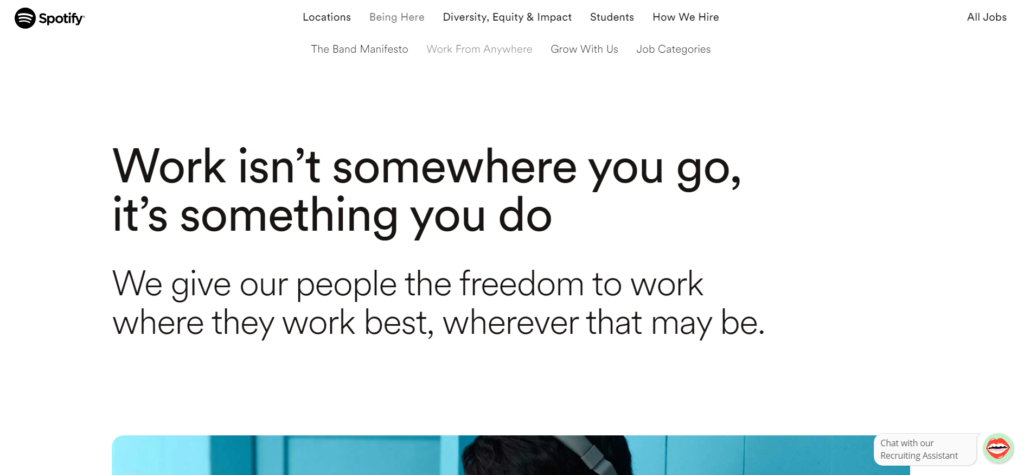As companies globally are welcoming their team back to the office, there is a pushing demand for the adoption of flexible working models. While some employees want to continue with remote working, there is a significant number of employees who look forward to the hybrid working model because of the flexibility it offers.
The hybrid working model seems to be a preferred choice among employers. For one, a hybrid working model redefines team collaboration and promotes healthy team-building. Secondly, it boosts team productivity by creating a motivating work environment for all.
No wonder, 72% of businesses wish to adopt a hybrid work strategy.
However, since hybrid working is a fairly new and evolving concept, most businesses aren’t clear on how it works.
In this article, we will learn more about the hybrid work approach and the benefits it offers for businesses.
Hybrid work is a flexible, people-first work approach that enables employees to choose where they want to work from. This model lets employees work either from the comfort of their homes, the office, or both.
With this working model, employers can build a dynamic workplace that is no longer restricted to the four walls of the office. Instead, the entire workforce is spread across the office, coworking spaces, and employees working from their homes.
Leading companies from all around the world, such as Reddit, Spotify, Twitter, HubSpot, and more have already adopted a hybrid working approach.
Spotify launched its ‘Work from Anywhere‘ program in February 2021 which offers employees the flexibility to work from home, from the office, or a combination of the two. Spotify has also offered its remote employees the flexibility to choose the city they wish to work from. If the city does not happen to have a Spotify office, the company supports the employees with a coworking space membership.

Similarly, Atlassian has implemented a ‘work from home forever’ policy that entitles employees to permanent remote working flexibility. However, their offices are kept open for the employees who wish to visit and work from the offices.
Let us now look at the various types of hybrid working models.
In this type of hybrid working model, the office is designated as the primary place of work. However, the employees can work from both the office and their homes. One of the biggest disadvantages of this model is that the remote team often feels alienated. This results in lesser engagement from remote employees and decreased productivity.
As the name suggests, this model offers employees the complete flexibility to work from home as the entire team is spread across different locations and time zones. However, some employees might be required to work from the office in case their jobs demand their presence.
Companies following the remote-first approach of hybrid work often organize annual retreats where all the remote employees meet, interact with each other, and spend some quality time.
This type of hybrid working model requires employees to work from the office a few times a week. For example, employees are instructed to come to the office three days a week. Some organizations could also have firm guidelines about working from the office. For instance, employees are instructed to work from the office on specific days of the week.
The hybrid office setups are designed to accommodate employees’ needs. It offers the freedom and flexibility to carry out their responsibilities without disrupting their personal lives. It empowers employees to work from their desired work location allowing them to dedicate complete focus to their tasks.
The work flexibility also brings about a refreshing change helping them balance workloads, invest in learning new skills, and submit the assigned work as per the expectations. With a hybrid work model, employees can attend to their personal lives along with their professional commitments on time.
For example, an employee who has a doctor’s appointment can take a break and visit the doctor instead of taking an entire day off. This is possible because of the flexibility hybrid work offers. Thus, employees can carry out their chores without affecting the quality of work.
The work-life balance that hybrid working offers helps employees to balance their personal and professional lives. This has a positive impact on the employees’ physical and mental health.
Hiring the right talent has always been a challenge for employers. Owing to geographical barriers, employers are not able to tap into a larger talent pool. However, the flexibility hybrid work model provides helps employers widen their candidate search across borders.
According to Zippia, 59% of employees revealed that they are more likely to choose an employer that allows remote work over one that doesn’t. They prefer remote working for the benefits it offers, such as improved work-life balance, freedom, better productivity, and more. Hybrid work models help employers to attract and hire such candidates without any hassles.
The hybrid working model supports employers with an effective recruitment process that builds a team of expert professionals.
A high attrition rate is often a sign that employees aren’t happy with the work environment and company culture. Hence, companies invest a lot of time and effort in upholding a strong employee-centric culture.
The hybrid work model helps employers offer attractive and compelling benefits to the employees. Putting the employees first or the people first approach helps the organization build strong relationships with the employees. With this approach, employees feel valued and devoted to the company’s mission. This directly contributes to higher employee retention.
Here are a few tips to boost employee retention.
The hybrid work model helps employers reduce the costs associated with the company operations.
As hybrid work models allow employees to work from the office and home at their convenience, there will be fewer people in the office at any given time. Employers can reduce the amount of unused space either by renting those parts of the office to some other companies or moving into a smaller space altogether.
Renting a coworking space like The Address is also an ideal option. The Address provides tailored office solutions to help businesses scale. These coworking spaces are equipped with modern amenities, such as the best infrastructure, high-speed internet, functional kitchens, and more. All this brings down a business’s operating costs, thus contributing to profits.
Working from home full-time can make employees feel lonely and distracted. The office environment takes away the boredom and fosters team spirit. The hybrid work model gives employees a chance to meet the team and interact with them at a personal level.
Hybrid work also promotes better collaboration and fosters good work relationships within the teams.
The hybrid work model is here to stay. As we mentioned above, the hybrid work culture offers incredible benefits to the employer and employees. It’s a win-win situation.
Companies should strategically plan and set up a hybrid work strategy so that the on-site team and remote workers can collaborate and work efficiently. If implemented correctly, the hybrid work model will certainly take your company to great heights.
What are the best locations for Coworking Space In India

